

Center for Humane Technology. Ten tech. Tech 4 Housing. Living Cities. Civic Tech and Data Collaborative. Three steps to leverage data and technology to help low-income residents. Many local organizations help people with limited resources achieve upward mobility and stability.
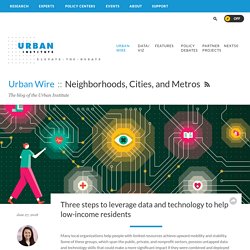
Some of these groups, which span the public, private, and nonprofit sectors, possess untapped data and technology skills that could make a more significant impact if they were combined and deployed strategically. The Civic Tech and Data Collaborative—guided by the Urban Institute’s National Neighborhood Indicators Partnership (NNIP), Living Cities, and Code for America—brought together local government officials, civic technologists, and community data organizations across seven cities to explore harnessing data and technology to benefit low-income residents.
The collaborative demonstrated three steps cities should take to successfully leverage data and technology to improve the lives of residents with limited economic resources. 1. Build intentional, lasting relationships across sectors. 2. 3. Home - INRIX. Video Surveillance Systems - Complete Guide. Audio Surveillance Video and image feeds have proved invaluable for surveillance – but there’s room for more functionality by using audio.
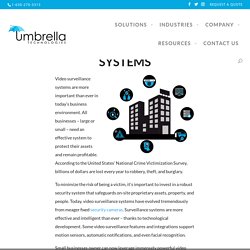
Human beings have five senses that collectively allow us to accurately range our environment. Therefore, it only makes sense that a security system that engages as many senses as possible is more effective. And because it’s not practical to engage smell, taste, and touch remotely, the most effective video surveillance systems combine sight and hearing to enhance security coverage. Audio augments video surveillance to better detect and interpret incidents in real-time. It is important to consider the use of audio before investing in a video surveillance system. The more advanced cameras in the market allow two-way audio between people on either side of the video surveillance system. Expert Tip: Always consult local authorities or legal experts before deploying an audio solution. Evidence-based indoor design is more important than ever. The coronavirus disease 2019 (COVID-19) pandemic has transformed our homes into schools, workplaces, recreational centers, and experimental kitchens, rendering us increasingly aware of the opportunities and constraints built into their design.
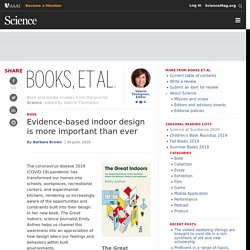
In her new book, The Great Indoors, science journalist Emily Anthes helps us channel this awareness into an appreciation of how design alters our feelings and behaviors within built environments. Although research on the benefits of nature is booming, the reality is that North Americans and Europeans spend about 90% of their time indoors. Worldwide, the indoor environment is expected to double in square footage by 2060. Anthes takes readers on a tour of the behavioral implications of indoor design, highlighting apartments created for neurodiverse individuals, dome homes, and electronically monitored housing.
She also explores hospitals, prisons, and public spaces designed to encourage physical activity. About the author About the author. SurveillanceCapitalism – Digital Manipulation is Fracturing Democracy. Creating today what really matters for tomorrow. Giorgio Primiceri. Working papers How to Estimate a VAR after March 2020 (with Michele Lenza), June 2020.
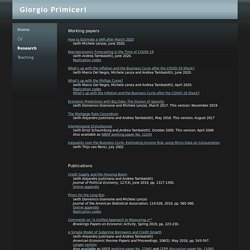
Macroeconomic Forecasting in the Time of COVID-19 (with Andrea Tambalotti), June 2020. Replication codes What's up with the Inflation and the Business Cycle after the COVID-19 Shock? (with Marco Del Negro, Michele Lenza and Andrea Tambalotti), June 2020. What's up with the Phillips Curve? Blue Zones—Live Longer, Better. Giorgio Primiceri. Software Is Eating the World. Smart Energy Technology - Smappee.
Headset and Heart. The Future of Home Automation - new market research. NEW YORK, May 17, 2011 /PRNewswire/ — Reportlinker.com announces that a new market research report is available in its catalogue: The Future of Home Automation [mHealthTalk comments and emphasis added] Introduction This [$2,875] report examines how consumers and governments are creating a booming market for “smart home” devices.
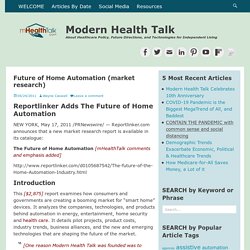
It analyzes the companies, technologies, and products behind automation in energy, entertainment, home security and health care. It details pilot projects, product costs, industry trends, business alliances, and the new and emerging technologies that are shaping the future of the market. [One reason Modern Health Talk was founded was to apply smart home technologies to the task of home healthcare, exploiting Wayne Caswell’s extensive experience in this area. Building Wellness Institute. Since 2005, the Building Wellness Institute has been helping building owners, facilities managers and service providers adopt new and more efficient approaches to cleaning that protect the environment and the health of building occupants.

The Problem: Despite the growing popularity of “being green,” few people realize that a significant public health issue exists in the way that we clean and maintain our nation’s schools, office buildings, colleges and universities. Cleaning chemicals, processes and equipment can cause poor indoor air quality and contribute to a wide range or respiratory and health problems.
The Proof: A landmark study by Dr. Apartment Industry & Its Residents Contribute $3.4 Trillion to the National Economy. WASHINGTON, D.C. – A new Hoyt Advisory Study commissioned by the National Multifamily Housing Council (NMHC) and National Apartment Association (NAA) reveals that the apartment/multifamily industry and its residents annually contribute more than $3.4 trillion to the national economy.
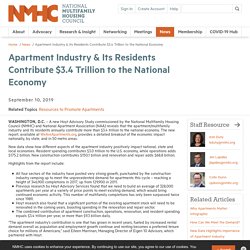
The new report, available at WeAreApartments.org, provides a detailed breakout of the economic impact nationally, by state, and in 50 metro areas. New data show how different aspects of the apartment industry positively impact national, state and local economies. Resident spending contributes $3.0 trillion to the U.S. economy, while operations adds $175.2 billion. Accounts - Account Recovery. <section class="ius-hosted-ui-main-container"><header id="ius-no-javascript-header-container" class="ius-header-container"></br><span id="ius-no-javascript" class="ius-header"><p style="text-align: center">Your browser does not support JavaScript or JavaScript is disabled.
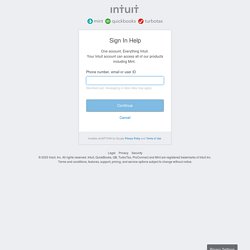
</p><p style="text-align: center">Please turn on JavaScript or update your browser. </p></span></header><br /><p style="text-align: center"><a href=" More</a><p></section> Oops. No match found. Make sure you're using the primary taxpayer's information (the first person listed on your filed return). Economic Mobility and Opportunity - Bill & Melinda Gates Foundation. We have identified five areas where we hope to help others expand and extend their work: Closing Data Gaps Local leaders have told us they need better data on the fundamental factors contributing to poverty in America.
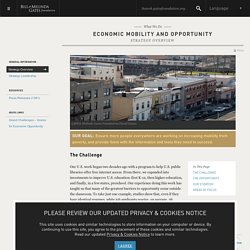
We don’t know what characteristics of neighborhoods have the greatest impact on mobility. We don’t know what causes violence to go down in some cities, but not others. The field needs to fill these gaps to diagnose specific barriers to mobility and develop interventions that work. To that end, we’ve funded work to measure eviction rates for communities across the country. We’ve also funded research that tracks how economic mobility varies by neighborhood. Empowering Local Actors Many communities around the country are trying hard to respond to the daily realities of poverty.
Personalized Merchandise for Virtual Events — YR. Ideas. Generative Design. Center for Health Equity. COVID-19.